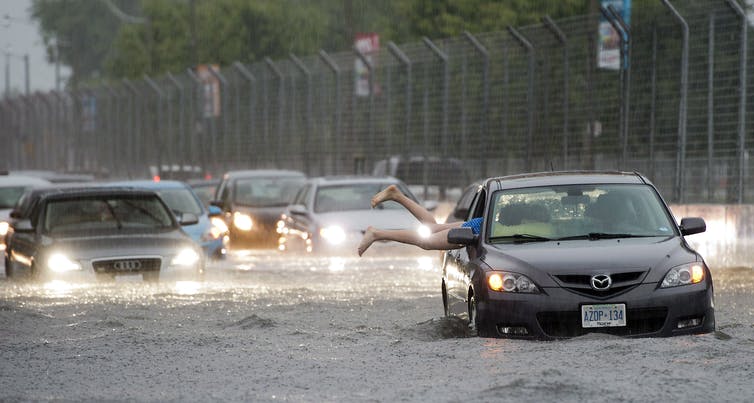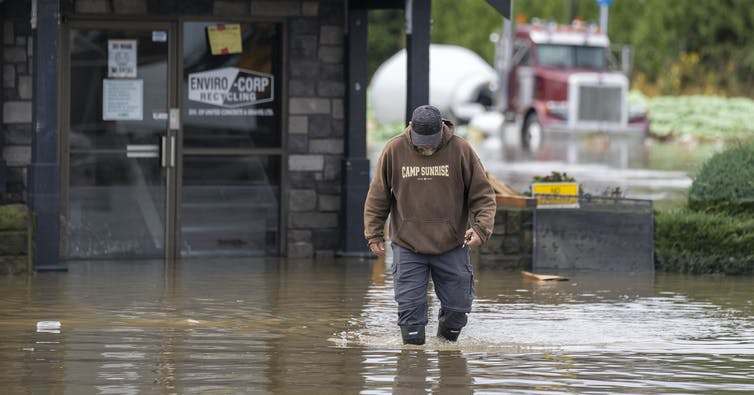Insurance isn’t enough: Governments need to do better on natural disaster resilience

A woman and children who were stranded by high water due to flooding are rescued by a volunteer operating a boat in Abbotsford, B.C., in November 2021. The Insurance Institute of Canada forecasts that annual insured losses from natural disasters could increase to $5 billion within the next 10 years. THE CANADIAN PRESS/Darryl Dyck
The massive floods in British Columbia in November 2021 demonstrated the devastation that natural disasters can cause in Canada. Prior to 2010, it was rare for annual insured losses from natural disasters in Canada to exceed $1 billion, but now insured losses of $3 billion are not uncommon.
Canada is expected to become wetter, stormier, warmer and to experience more severe connective storms and wildfires. The Insurance Institute of Canada forecasts that annual insured losses could increase to $5 billion within the next 10 years.
Private insurance plays an essential role in supporting the resiliency of communities by providing financial compensation for losses that aid in recovery. Insurance company Munich Re notes that, after accounting for per capita income, countries with greater insurance coverage are more resilient to natural disasters.
However, insurance works best protecting households and communities against idiosyncratic low-frequency, high-severity events. As extreme weather events become more common, relying on insurance alone to protect Canadians against severe weather is not sustainable. It is critical that an integrated and holistic approach to mitigate and manage losses from natural disasters is developed.
Communities and property owners need to be partners in reducing losses by undertaking mitigation activities to reduce the severity of wind, water and wildfire events. However, the largest role falls upon all levels of government to protect Canadians against the impact of catastrophic weather events.
Land-use planning and mitigation
To create more resilient communities, governments need to invest in mitigation, adaptation and risk-prevention activities. Climate change, expanded development and population growth have resulted in the need for updated risk assessments, especially up-to-date flood maps.

Prime Minister Justin Trudeau looks over maps as he surveys the damage left behind from the flood waters in Abbotsford, B.C. in November 2021. Governments need to invest in risk-prevention activities to create communities that are more resilient to natural disasters.
THE CANADIAN PRESS/Jonathan Hayward
In high-risk areas, future development must be prohibited, and governments should buy out existing properties. Better flood maps will enable governments to purchase high-risk properties before a devastating flood, and the land could be transformed to help minimize flooding in adjacent areas.
To withstand future extreme weather events, building codes and standards need to be revised. Whether it’s new construction of buildings or infrastructure, retrofitting property or repairing property after a loss, building codes need to be forward-looking.
Insurance and disaster financial assistance
After an extreme weather event, a province or territory may declare the event to be eligible for disaster assistance, with funding available from the province via Disaster Financial Assistance (DFA). DFA is available to property owners and communities for losses that are not covered by insurance companies — DFA does not pay for losses for which insurance is “reasonably and readily” available.
Prior to the flooding events in both Calgary and Toronto in 2013, Canadian homeowners could not buy insurance for overland water damage, but now most insurers offer some level of flood insurance, except in very high-risk areas.
This introduces inequity among homeowners — those who live in the highest risk areas cannot purchase insurance and therefore can receive DFA after a loss, but those living in moderate to high-risk areas where insurance is “reasonably and readily” available may not be able to afford coverage and therefore not be eligible to receive DFA.

A woman gets back into her flooded car on Lakeshore Boulevard, Toronto in July 2013. The floods from that year resulted in insurance companies offering overland flood insurance, in addition to standard sewer backup policies.
THE CANADIAN PRESS
Because the term “reasonably and readily” is not well-defined, ambiguity exists regarding who can receive DFA and who cannot. If the limitations around DFA are not fully understood by property owners, or if governments do not clearly define “reasonably and readily,” the incentive to purchase flood insurance is reduced.
Property owners need information regarding the value of purchasing flood insurance and insurers can provide important information about how to mitigate losses from flooding.
Furthermore, owners need to be counselled very carefully on the consequences of not purchasing flood coverage, and the provincial and territorial governments need to remain committed to not pay DFA for losses that could have been insured.
Private-public partnerships
The private insurance market, which has an important role to play in financing losses from natural disasters, has its limitations. The risks associated with some properties exceed the appetite of insurers and some perils have the potential to cause losses too large for the Canadian insurance market to cover.
To achieve sustainable flood insurance coverage, a public-private partnership is needed, whereby the government’s role is to support an insurance risk-sharing pool for high-risk properties that, otherwise, would not be able to purchase coverage. This will help reduce the reliance on DFA and provide information to homeowners regarding the risk they face.

A man walks through rising flood waters crossing into Canada from the United States in Abbotsford, B.C in November 2021.
THE CANADIAN PRESS/Jonathan Hayward
Governments also have an important role in providing a safety net for very large losses. The industry guaranty fund, the Property and Casualty Insurance Compensation Corporation, has determined that a catastrophic loss exceeding $35 billion in insured losses would overwhelm the Canadian insurance industry and require government intervention. Such intervention could take the form of providing a layer of insurance coverage for catastrophic losses, or a liquidity or solvency backstop.
Ultimately, insurance and adaptation will not solve the problem of severe weather losses. We need to commit to sincere and strong action on climate change to reduce the frequency and severity of weather events. Some of the tools discussed here — insurance, strengthening building codes, effective mitigation and creating public private partnerships — can be leveraged to build a more resilient society.

Anne E. Kleffner receives funding from SSHRC, Alberta Finance.
Mary Kelly receives funding from SSHRC and is a director at Heartland Farm Mutual Insurance Company.





